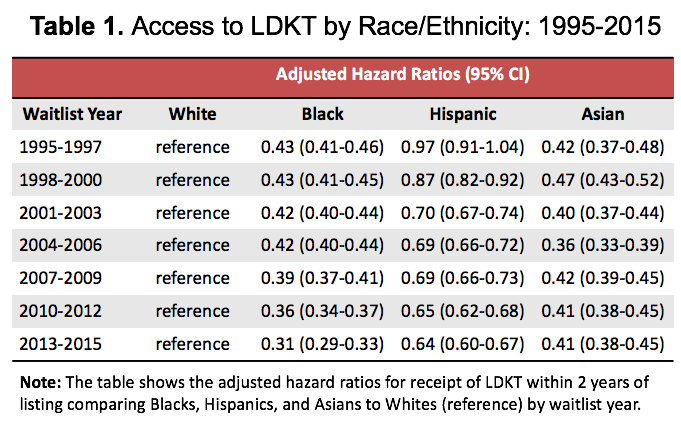Just Keeps Getting Worse: Racial and Ethnic Disparities in Access to Live Donor Kidney Transplantation in the US Over the Last Twenty Years.
1Johns Hopkins University, Baltimore
2Northwestern University, Chicago
3Duke University, Durham
Meeting: 2017 American Transplant Congress
Abstract number: 495
Keywords: African-American, Hispanic
Session Information
Session Name: Concurrent Session: Disparities in Kidney Transplantation
Session Type: Concurrent Session
Date: Tuesday, May 2, 2017
Session Time: 4:30pm-6:00pm
 Presentation Time: 4:30pm-4:42pm
Presentation Time: 4:30pm-4:42pm
Location: E451a
Over the past two decades, there has been increased attention and efforts to reduce racial/ethnic disparities in access to live donor kidney transplantation (LDKT) in the US. The goal of this study was to investigate if these efforts have been successful. METHODS: Our study population included 497,972 adult first-time kidney transplant waitlist candidates captured in the Scientific Registry of Transplant Recipients (SRTR) from 1995 to 2015. Using Cox regression models, we examined changes over time in receipt of a LDKT. We adjusted all models for differences in ESRD etiology, age, gender, waiting time, insurance, education, employment status, body mass index, panel reactive antibody, and ABO blood type. We also tested whether waitlist year was an effect modifier of racial/ethnic differences in LDKT access. RESULTS: Over this period, receipt of LDKT within 2 years of listing decreased from 26.4% to 22.5% for Whites, from 11.7% to 9.4% for Asians, from 10.5% to 6.0% for Blacks, and from 22.6% to 12.0% for Hispanics. In the 1995-1997 cohort, Blacks were 57% (aHR: 0.43, 95% CI: 0.41-0.46) and Asians were 58% (aHR: 0.42, 95% CI: 0.37-0.48) less likely to receive LDKT than Whites, but Hispanics were equally likely (aHR: 0.97, 95% CI: 0.91-1.04). However, in the 2013-2015 cohort, Blacks were 69% (aHR: 0.31, 95% CI: 0.29-0.33), Asians were 59% (aHR: 0.41, 95% CI: 0.38-0.45), and Hispanics were 36% (aHR: 0.64, 95% CI: 0.60-0.67) less likely to receive LDKT than Whites. (Table 1) CONCLUSIONS: Racial/ethnic disparities in access to LDKT have worsened over the past two decades, particularly for Blacks and Hispanics. Effective interventions to reduce LDKT disparities must be adopted and scaled nationally to accelerate equitable access to LDKT in the US. 
CITATION INFORMATION: Purnell T, Luo X, Kucirka L, Henderson M, Gordon E, Boulware L, Segev D. Just Keeps Getting Worse: Racial and Ethnic Disparities in Access to Live Donor Kidney Transplantation in the US Over the Last Twenty Years. Am J Transplant. 2017;17 (suppl 3).
To cite this abstract in AMA style:
Purnell T, Luo X, Kucirka L, Henderson M, Gordon E, Boulware L, Segev D. Just Keeps Getting Worse: Racial and Ethnic Disparities in Access to Live Donor Kidney Transplantation in the US Over the Last Twenty Years. [abstract]. Am J Transplant. 2017; 17 (suppl 3). https://atcmeetingabstracts.com/abstract/just-keeps-getting-worse-racial-and-ethnic-disparities-in-access-to-live-donor-kidney-transplantation-in-the-us-over-the-last-twenty-years/. Accessed January 7, 2026.« Back to 2017 American Transplant Congress
